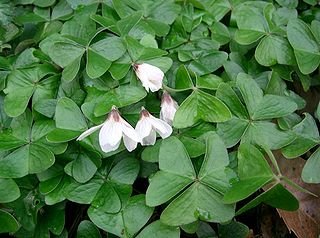
Oxalis is a large genus of flowering plants in the wood-sorrel family Oxalidaceae, comprising over 550 species. The genus occurs throughout most of the world, except for the polar areas; species diversity is particularly rich in tropical Brazil, Mexico, and South Africa.
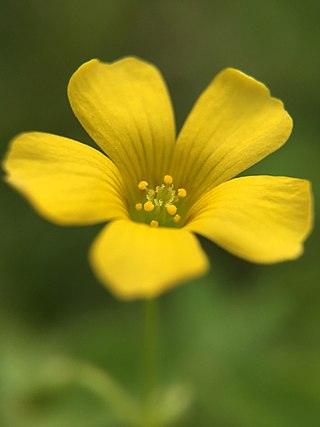
Oxalis corniculata, the creeping woodsorrel, procumbent yellow sorrel or sleeping beauty, is a somewhat delicate-appearing, low-growing herbaceous plant in the family Oxalidaceae. It resembles the common yellow woodsorrel, Oxalis stricta.

Trifolium aureum, known by the various common names large hop trefoil, large trefoil, large hop clover, golden clover or hop clover, is a species of flowering plant native to much of Eurasia.

Trifolium campestre, commonly known as hop trefoil, field clover and low hop clover, is a species of flowering plant native to Europe and western Asia, growing in dry, sandy grassland habitats, fields, woodland margins, roadsides, wastelands and cultivated land. The species name campestre means "of the fields".
Yellow woodsorrel may refer to any member of the woodsorrel genus (Oxalis) with yellow flowers, but especially:
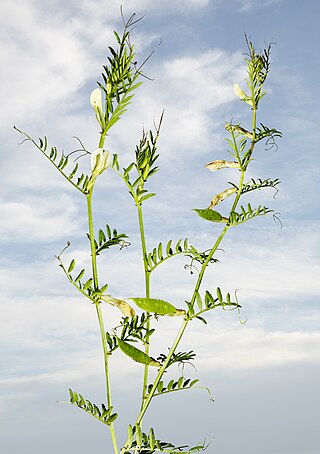
Vicia lutea is a species of flowering plant in the bean family Fabaceae.

Oxalis stricta, called the common yellow woodsorrel, common yellow oxalis, upright yellow-sorrel, lemon clover, or more ambiguously and informally "sourgrass", "sheep weed", or "pickle plant", is a herbaceous plant native to North America, parts of Eurasia, and a rare introduction in Britain. It tends to grow in woodlands, meadows, and in disturbed areas as both a perennial and annual. Erect when young, this plant later becomes decumbent as it lies down, and branches regularly. It is not to be confused with similar plants in the same genus which are also often referred to as "yellow woodsorrel".
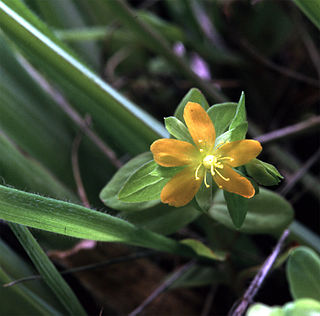
Hypericum anagalloides is a species of flowering plant in the St. John's wort family Hypericaceae. It is known by the common names creeping St. John's-wort, tinker's penny and bog St. John's-wort.
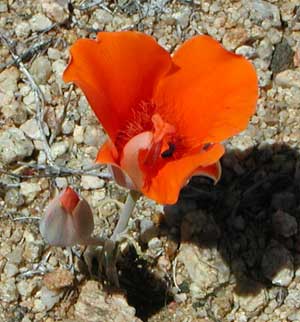
Calochortus kennedyi is a North American species of flowering plant in the lily family known by the common name desert mariposa lily.
Hosackia pinnata, synonym Lotus pinnatus, is a species of legume native to western North America from British Columbia to California. It is known by the common names meadow bird's-foot trefoil and bog bird's-foot trefoil. Its distribution extends into British Columbia in just a few rare occurrences near Nanaimo. It grows in moist to wet habitat, such as bogs and spring meadows. It is a hairless perennial herb lined with leaves each made up of green oval leaflets each 1 to 2.5 centimeters in length. The inflorescence is an array of up to 10 pealike flowers between 1 and 2 centimeters long. Each flower has a bright yellow banner, or upper petal, and white lower petals. The fruit is a slender, elongated legume pod up to 5 centimeters long but just a few millimeters long.

Oxalis incarnata is a species of flowering plant in the woodsorrel family known by the common names pale pink-sorrel and crimson woodsorrel. It is native to southern Africa, but it can be found on other continents where it is an introduced species, often the descendant of garden escapees. It is grown and kept as an ornamental plant. This is a perennial herb growing from a system of rhizomes and bulbs. The branching, hairless stem grows to nearly 30 centimeters in maximum length. There may be small bulblets located along the stem above ground. The leaves are borne on long petioles in erect bunches, each leaf made up of three leaflets. The solitary flower arises on a peduncle. Each flower has five white to light pink petals.
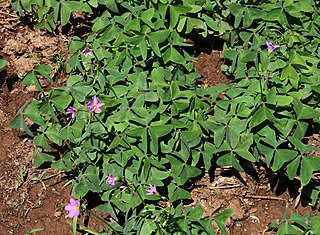
Oxalis latifolia is a species of flowering plant in the woodsorrel family known by the common names garden pink-sorrel and broadleaf woodsorrel. It is native to Mexico and parts of Central and South America.

Oxalis purpurea is a species of flowering plant in the woodsorrel family known by the common name purple woodsorrel. It is native to southern Africa, including South Africa, but it is known on most continents as an introduced species. It is cultivated as an ornamental plant. This perennial herb grows from bulbs and produces a few basal leaves and flowers. The leaf is made up of three hairy leaflets of various shapes which are dark green in color, turning streaked and spotted with brown as they dry. The solitary flower arises on a stemlike peduncle and has five petals which may exceed two centimeters in length. The flower may be white to pink or purple-red.

Penstemon gracilentus is a species of penstemon known by the common names slender beardtongue and slender penstemon. It is native to the mountains and sagebrush plateau of northeastern California, western Nevada, and southern Oregon, where it grows in forest, woodland, and scrub habitat. It is a perennial herb producing upright branches to about 65 centimeters in maximum height, the stems developing woody bases. The leaves are up to 10 centimeters in length and linear or lance-shaped. The glandular inflorescence produces several tubular purple flowers up to 2 centimeters long. The mouth of each flower may be hairless or coated in long hairs, and the staminode usually has a coat of yellow hairs.

Pyrrocoma carthamoides is a species of flowering plant in the family Asteraceae known by the common name largeflower goldenweed. It is native to western North America from British Columbia to northeastern California to Wyoming, where it is known from grassland, woodlands, forests, barren areas, and other habitat. It is a perennial herb growing from a taproot and producing one or more stems to about half a meter in maximum length, the stems reddish-green and leafy. The largest leaves are at the base of the stem, measuring up to 20 centimeters long, lance-shaped with spiny sawtoothed edges. Leaves higher on the stem are smaller and hairier. The inflorescence is a single flower head or a cluster of up to four. Each bell-shaped head is lined with phyllaries each up to 2 centimeters long. It has many yellow disc florets surrounded by a fringe of yellow ray florets up to 7 millimeters long; ray florets are occasionally absent. The fruit is an achene which may be well over a centimeter in length including its pappus.
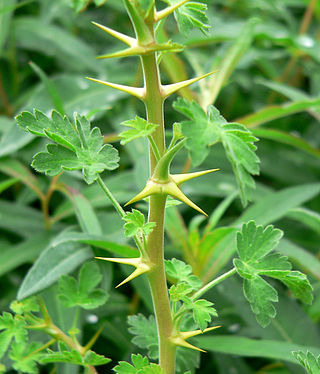
Ribes montigenum is a species of currant known by the common names mountain gooseberry, alpine prickly currant, western prickly gooseberry, and gooseberry currant. It is native to western North America from Washington south to California and east as far as the Rocky Mountains, where it grows in high mountain habitat types in subalpine and alpine climates, such as forests and talus. It is a spreading shrub growing up to 1.5 meters tall, the branching stems covered in prickles and hairs and bearing 1 to 5 sharp spines at intervals.

Stanleya viridiflora is a species of flowering plant in the family Brassicaceae known as green princesplume and green-flowered prince's plume. It is native to the western United States, where it occurs in sagebrush and plateau habitat, often on rocky calcareous, sandstone, clay, shale, or volcanic soils.
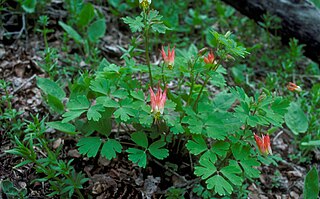
Aquilegia elegantula is a species of columbine known by the common name western red columbine. It is native to the southwestern United States, particularly the Four Corners states, and northern Mexico, where it grows in moist areas in mountain coniferous forests. It is a rhizomatous perennial herb growing 10 t 60 centimeters tall. The green leaf blades are borne on long, slender petioles and divided into three leaflets which each have rounded lobes along the front edges. The flower has five long petals up to 3 centimeters in length including their elongated, knob-tipped spurs. The petals are bright red in the spurs and lighten to yellow-green or orange at the tips. Between the petals are the oval-shaped sepals, which are reddish to yellowish in color and are held parallel to the petals. Flowers often droop such that the mouth is toward the ground and the spurs point up; the flowers are pollinated by the broad-tailed hummingbird.

Oxalis dillenii, also the southern wood-sorrel, slender yellow woodsorrel, and Dillen's oxalis, is species in the wood-sorrel family Oxalidaceae in the genus Oxalis. Like other Oxalis species, the leaves of this plant resemble clover leaves, with three leaflets. Flowers have five yellow petals that are 4 to 10 millimetres in length. Leaflets are 1 to 2 centimetres wide with pointed hairs. Fruits are rather brown and 1.5 to 2.5 centimetres. It is often considered a weed, and can be found worldwide, but likely originated in North America.

Hypericum swinkianum, known as Swink's St. John's wort, is a shrub in the St. John's wort family. It was named after Chicago Region botanist Floyd Swink (1921-2000).


















